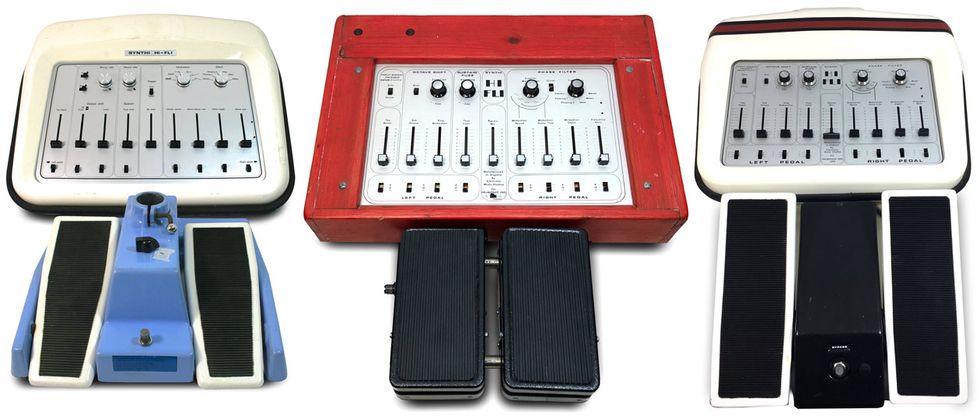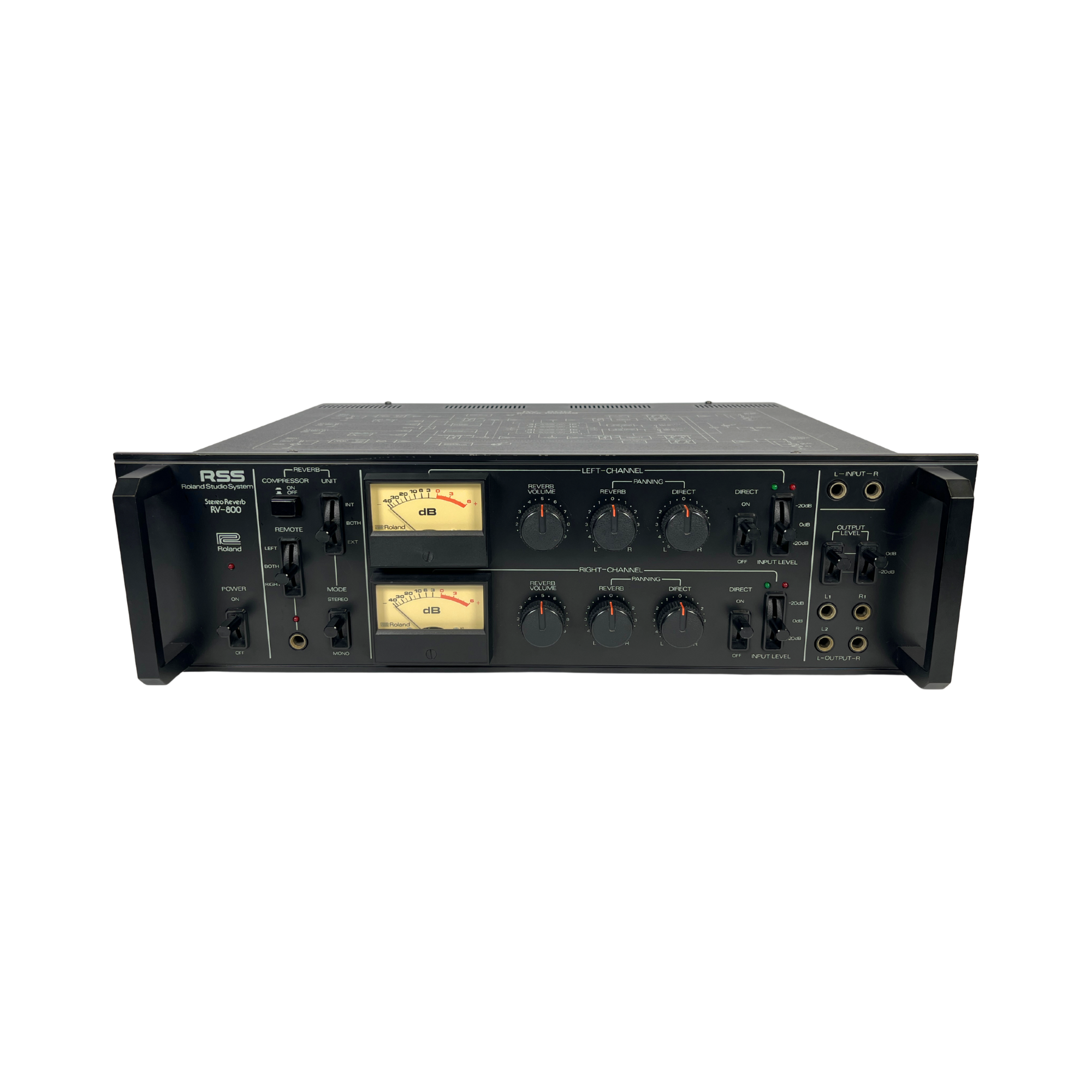Number one in Analogman Tom's list of rare guitar effects from his
excellent book.
Used by David Gilmour - see
this Gilmourish blog for further details - he bought a prototype in 1972 and from what he recalls it was “very, very expensive”; Gilmourish suggest it was used during the recording of Dark Side Of The Moon though DG's long time tech, Phil Taylor, thinks it wasn't.
In a way it is immaterial whether or not it was used on DSOTM: the Hi-Fli is your route to creating Gilmour style sounds and effects - nothing else sounds quite like it. I'd keep mine just for the two phaser and three vocal wah settings called Waa, Waw and Meow. And it's not just for guitarists - running keys/synths and drum machines through it can be a shortcut to vintage sonic nirvana.
This unit comes with a dual footswitch unit and has just been serviced by an EMS specialist.
Designed by David Cockerell in 1971 for EMS: with only 350 units originally produced, the Hi-Fli was actually referred to as a synthesizer in the original ad, but it’s basically an analog multi-effect processor, which can be used on vocals, guitars, organs, synths etc. It has two footpedals, which could be routed as control voltages/expression pedal to any of the slider functions. It’s got no memory to bank up settings, – everything is in real-time, so one had to manually tweak the sliders for each tone change. You'll suddenly hit upon an amazing combination while tweaking the knobs - be sure to hit record as repeating it can prove elusive.
Product photos include a shot of David in his home studio in 1972 with a prototype of the Hi-Fli.
Top Boost: Provides up to 30 db treble boost.
Octave Shift: Drops the pitch by an octave.
Buzz Switch: Adds high frequencies overtones to the sub-octave signal.
Ring Mod: Produce an octave higher when a signle note is played and the typical ring modulation when two or more strings are played.
Decay Rate: A rotary control controls the decay time of the ring mod and octave shift signal level.
Sustain Fuzz: Special circuits detect the beginning and end of each note and apply upper harmonics.
Attack Rate: A rotary control varies the rise time of Sustained Fuzz signal. Notes can be sustained even though the original signal has dropped by more than 20db.
Pedal Switches: The switches under the sliders combine the pedal control with the manual sliders. Selections of switches with pre-set slider positions enable the pedal to change treatments instantly.
Solo/Strum: This switch alters the Hi-Fli’s sensitivity to signal attacks and should be set to more sensitive for single notes (i.e solo).
Bypass Mix Fader: This central slider controls the mix of the original and treated sound. In the high position only the input pre-amplifier is in-circuit. The bypass footswitch gives instant access to this position. The output from the Octave shitft, Ring Modulator and Fuzz Sustain sections are re-combined and go to the phase filter and modulator section.
Control Modulation Selector: 6 position control knob.
Treatment Selector: There are six distinct modes of operation – Vibrato, two modes of Phasing, normal WAA-WAA (1 resonant peak), WAW-WAW (six resonant peaks) a completely new sound, and finally MEOW (two sets of three resonant peaks moving in oppisite directions.
Modulation Speed: This slider operates in the first 4 positions of the control modulation selector, providing a fine frequency control.
Modulation Ramp Time: Operates in positions 3 to 6 of the conrol modulation selector.
Modulation Depth: Controls the depth of the Phaser.
Frequency shift: This controls the frequency domain in which the modulation waveform operates, being central for symmetrical modulation.
L.E.D selectors: Two light emitting diodes show the movement of the modulation waveform.
========
In my experience, there is one unit that stands above the rest: the EMS Synthi Hi-Fli. This is the ultimate vintage guitar pedal, whether for its features, sound, looks, size, scarcity, price, or simply its star quality. I’ve been fortunate to own four or five over the years, with some overlap between different variations. At one point, I had a rare early prototype and one of the last MkII units. They all sound different, and each one has its own unique character. This is due to the varying degrees by which the 40-year-old components in these complex, discrete circuits have aged. I could have justified keeping them all on the basis that each had unique qualities I enjoyed. But my keeper unit is one of the last produced by EMS. Built starting in 1972, the Hi-Fli was designed a year earlier by David Cockerell, who was also responsible for such legendary synths as the EMS VCS 3, Synthi AKS, and Synthi 100. In ’74, he moved to Electro-Harmonix, where he designed many classic pedals, including the Small Stone, Electric Mistress, 16 Second Digital Delay, and Microsynth.
David Gilmour of Pink Floyd is the most renowned early adopter of the Hi-Fli. He began using a prototype onstage in 1972-’73 and in recording
Dark Side of the Moon. A Hi-Fli is also visible in the film
Pink Floyd: Live in Pompeii. He has two units to this day, though Floyd gear expert and Gilmour tech Phil Taylor maintains that he didn’t use the Hi-Fli extensively. The prototype was displayed at the stunning
Pink Floyd: Their Mortal Remains exhibit at London’s Victoria and Albert Museum last year. Around 350 Hi-Flis were made, and other notable users include Steve Hackett of Genesis and Todd Rundgren.
Industrial designer Martin Holbrook’s iconic look for the Hi-Fli was a futuristic, curvaceous cream-colored fiberglass console, typical of late-’60s space-age design—although it was disparagingly referred to as “the toilet seat.” After the first 10 prototypes, which featured twin foot pedals built into the stand that supported it, the design was changed to a separate stand and pedals.
David Gilmour of Pink Floyd is the most renowned early adopter of the Hi-Fli. He began using a prototype onstage in 1972-’73 and in recording Dark Side of the Moon.
The prototype design, though undoubtedly far more aesthetically pleasing, was less successful ergonomically. Access to the pedals under the sizeable control section was difficult while playing guitar. After EMS ran out of cream fiberglass cases, the final 10 or so units produced by Robin Wood were housed in garish orange-painted wooden boxes.
While the early prototypes miss some of the later units’ improvements, and some mid-period Hi-Flis didn’t have the “growl” modification, all examples I’ve played have been utterly captivating. I know of no other effects unit that is as sonically versatile or as compelling and expressive. The Hi-Fli oozes inspiration, but if you find a sound you like, be certain to hit record quickly, because it can be difficult to precisely recreate settings. There are many variable parameters, and the slightest movement of each of nine faders has a significant impact on the sound. So, the Hi-Fli has all the flaws, foibles, and idiosyncrasies you’d expect in an analog synth from the early ’70s. It is one of those rare magical devices that surprises and delights one moment, only to obfuscate and exasperate the next.
Set the Controls for the Heart of the Sun
The Hi-Fli is complex and nuanced. Of course, you can just plug in and move sliders and switches until you get a sound you like. But the Hi-Fli is divided into two main sections by the bypass mixer, which controls the wet/dry mix. On the left are the top boost, octave shift, and sustain fuzz controls, and on the right are the controls for the stunning and multi-featured phase filter section. This is where you select and shape the various phaser, vibrato, and filter settings: vibrato, phasing 1, phasing 2, waw, wawa, and meow—tags that provide a tantalizing glimpse of what’s possible.

Three faces of the EMS Synthi Hi-Fli (from left to right): one of the 10 original prototypes with pedals directly beneath the unit; a final production model after EMS had run out of fiberglass housings, with the “growl” switch in the phase filter section and a bypass switch in the midsection; and a mid-period example without the growl mod. The middle unit is the author’s and can be heard in the sound clips online.
Running along the bottom are the switches to control the left and right foot pedals. Being able to select positive or negative voltage for the various sliders (or leave them off) for each pedal puts a vast array of control options at your disposal. On the top left is the solo/strum switch, which determines the attack/decay time sensitivity. Later units also feature the growl, which uses a subharmonic to modulate the phase filter, yielding even wilder sounds.
If I filled this entire magazine, I’d still fall short of conveying the depth, scale, and sheer craziness of the sounds the Hi-Fli can create. One minute you’re in the amphitheater at Pompeii making seagull noises; the next you’re like an axe-slinging Kraftwerk mannequin. Yet it also excels at gentle and subtle phasing and vibrato. This is a design of staggering quality and ambition with possibilities that stretch far beyond anything else created for use with an unmodified electric guitar in the ’70s. Like a guitar, the Hi-Fli will sound very different depending on who is playing it. Over the years, I’ve created all manner of scrumptious electronic noises using different Hi-Flis, and I still don’t feel I’ve come close to exhausting the sonic possibilities of this wondrous device. But in the neighborhood of $5,000 and up today, Hi-Flis are an investment in more than a learning curve.
Please also see: ems-synthi.demon.co.uk,
“AnalogMan’s Guide to Vintage Effects” by Tom Hughes
and the David Gilmour Gear Forum.
Condition
In excellent cosmetic condition with only minor scratches on the face. The case is very good with some dings and signs of wear. Please see photos or get in touch if you require more information on condition.
Voltage Information
220/240v unit. A step-up transformer will be required for use on 110/120v supplies. Please ask if you need advice on what to use. We do not recommend using cheap, generic Chinese mains transformers.
Tax
For sales in UK the price will include 20% VAT. Buyers elsewhere may incur VAT or other local taxes on import.





































